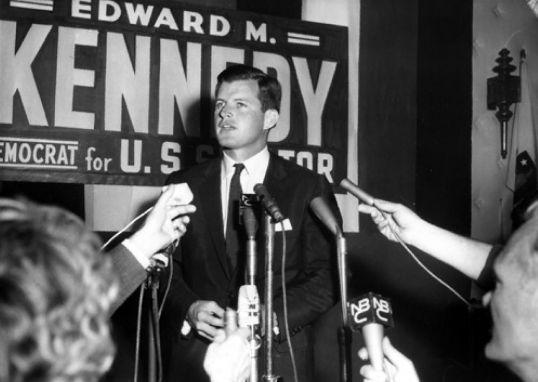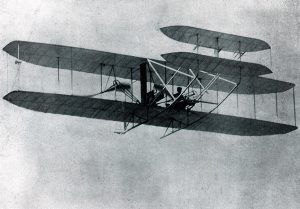Winner of the Fall 2019 StMU History Media Award for
Best Article in the Category of “United States History”
Many people associate the powerful Kennedy name with a famous presidency and an influential senatorial reign; however, not many people know that there is speculation of murder attached to their family history. Senator Edward (Ted) Kennedy, the brother of John F. Kennedy (JFK) and Robert Kennedy (RFK), was on the path to success, following in his brothers’ footsteps as he gained support to run for president in the early 1970s, but one mysterious night changed everything.1 On July 18, 1969, Ted Kennedy’s actions resulted in the death of Mary Jo Kopechne.2

Earlier that day, Ted Kennedy attended a private party on Chappaquiddick Island, Mass. It was attended by five men who had worked closely with the Kennedy family, along with six young, single women, commonly referred to as “The Boiler Room Girls.”3 These ladies were quite loyal to Robert Kennedy, especially Miss Mary Jo Kopechne, his talented campaign specialist who helped construct his anti-Vietnam War speech and other important announcements. She was specifically invited to this party by Ted Kennedy to witness the 46th-annual Edgartown Yacht Club Regatta as well as to participate in the festivities of the party.4
Between 11:15 PM and 12:45 AM (times greatly disputed during the subsequent trial), Ted graciously offered to drive Mary Jo to the ferry on Chappaquiddick Island, which was the only method of transportation back to their respective hotels in Edgartown. The timing of their departure is widely disputed, because it would answer important questions that were left unsolved in the case. Conspiracy theorists speculate that Ted Kennedy originally desired to take Mary Jo to an isolated beach to have an undisturbed affair, while others believe Ted’s claim that he left the party at 11:15 PM simply to return Kopechne to her hotel. According to Deputy Sheriff Look, the sheriff on duty that night who witnessed Ted Kennedy’s car turn towards Dike Bridge, the time was 12:45 AM, an hour and a half later than what Ted Kennedy later claimed in court. After he briefly crossed paths with the sheriff, Ted made a sharp, reckless, supposedly accidental turn onto Dike Road and his black Oldsmobile flew off Dike Bridge into Poucha Pond, flipped upside down, and submerged completely underwater.5
Water immediately rushed into the car, and according to Ted, Mary Jo struggled desperately next to him as they both fought to fill their lungs with air. Before losing consciousness, Ted managed to escape the car, “but [he had] no recollection of how [he] got out.”6 Mary Jo was not so lucky. She remained trapped in the submerged car while Ted swam to the water’s surface gasping for breath. Despite the strong water current, he claimed to have “repeatedly dove down to the car in an attempt to see if the passenger was still in [it].”7 Ted insisted his efforts to save Mary Jo only intensified his exhausted state. Kennedy then proceeded to make the fifteen-minute trek back to the cottage where the party was still in progress; none of the women there knew that they would never again see their good friend, Mary Jo Kopechne, alive.
When he arrived at the cottage, Ted quickly found his trusted cousin, Joseph Garghan, and friend, Paul Markham, before he returned to Poucha Pond to find Mary Jo. Garghan and Markham dove into the water looking for Mary Jo’s body, but once again, the strong current was unyielding, and the men couldn’t get close enough to locate her, much less dislodge her from the car. Ted Kennedy later stated that, before they drove Ted to the ferry crossing (that was no longer operating at that time of the night), he instructed them not to mention the incident to Mary Jo’s friends because it would simply alarm them. Without argument, they drove him to the crossing immediately. According to Ted’s testimony, he impulsively jumped into the water when he arrived and swam across the channel to Edgartown.8

Rather than call the police to report an accident and the possibility of a drowned victim, Ted Kennedy weakly staggered to his hotel room where he immediately collapsed on the bed. Later on, he woke up, walked outside his room, asked for the time, and went back into the room upon learning that it was 2:30 AM. He was awake and lucid, but he still didn’t call to inform the police. Ted later explained his conduct as being “irrational and indefensible and inexcusable and inexplicable… but it was a mental state of mind.”9 Senator Kennedy and/or his entourage made seventeen different calls that night, but not one of those calls were to the police, the only group of people who could have made an effective effort in saving Mary Jo Kopechne from death. According to the medical experts working on the case, it was likely that Kopechne had been alive in the car for a few hours after having been submerged underwater. Five calls from Chappaquiddick Island were billed to Senator Kennedy’s credit card, and twelve more were charged when he arrived at his hotel, the Shiretown Inn. Many wonder why none of these calls were used to save Mary Jo’s life.
The following morning around 8:00 AM, two young fishermen spotted a submerged car– Ted Kennedy’s car– in the water and immediately went to the closest house and called the authorities for help. Edgartown Police Chief Arena arrived thirty minutes later. The authorities knew of the accident before Senator Ted Kennedy ever reported it.

Meanwhile, Senator Kennedy didn’t give any indication that he had deliberately left the scene of an accident without reporting it to the authorities; he requested multiple newspapers from the front desk at the Shiretown Inn while dressed in his casual boating clothes before he ran into an acquaintance, who he had a leisurely fifteen minute chat with regarding their mutual love for boating.10 By this point, roughly eight hours had passed since Ted Kennedy left Mary Jo to drown in the submerged car in Poucha Pond under Dike Bridge.
When Police Chief Arena arrived at the scene, he swam out to the car and attempted to dive down into the water, but the rushing current was so intense his attempts were ultimately unsuccessful. Instead, he instructed his assistant to radio in the car’s license plate to identify the car’s owner.11 Deputy Sheriff Look recognized the car as the same one he had seen at 12:45 AM, the one that drove towards Dike Bridge. Chief Arena called John N. Farrar, an expert diver that worked for the fire department in the local area, who showed up minutes later. He hastily dove into the water despite the strong current and discovered Mary Jo in the back seat of the car; “her hands were still grasping the edge of the back seat– she tried to take advantage of the last bit of air.”12 Farrar believed that she died of suffocation in the car in her own air pocket (although experts claim she simply drowned), but she was alive for at least three or four hours.
Chief Arena contacted the medical examiner, who evaluated Mary Jo’s body. No more than ten minutes passed before he concluded that an autopsy wasn’t necessary for this particular case since there were no signs of foul play. Many people were appalled. An autopsy would have helped accurately determine how and when Mary Jo died. Therefore, the lack of the autopsy left many important questions unanswered.
Ted Kennedy arrived at Chappaquiddick Island around 9:00 AM that morning, completely unaware that the police knew his submerged car trapped a dead woman inside. He eventually went to the police station, but many skeptics believe his decision to report the accident was influenced by the sight of a hearse on the island. While at the station, Ted worked diligently with the police chief and Paul Markham to construct an outline of the previous night’s events. The part of his confession copy that angered many people was the fact that he claimed to have contacted the police upon “fully realiz[ing] what had happened” that morning; however, that would mean the sight of the hearse was what snapped him out of his dazed mental state, and some believe that he selfishly decided to admit his folly only when he realized there was no escaping the reality of his misdeed.13 Soon after he met with the police chief, Kennedy hastily left Chappaquiddick Island and stayed with his family stronghold in Hyannis Port.
After he attended Mary Jo Kopechne’s funeral, Senator Ted Kennedy consequently went to court, where he arrived with a neck brace on, much to the irritation of the citizens that kept with the media. The press documented Ted Kennedy as he flew kites and sailed after the dangerous Chappaquiddick accident. Critics believed that the Senator had a “selectively painful neck” and that he tried to evoke undeserved sympathy from the public.14
Finally, the trial began, and Ted Kennedy was charged with leaving the scene of an accident without notifying the authorities. As it progressed, certain measures were taken to ensure that Kennedy received a “fair” hearing, such as what was utilized as evidence, what information the jury was subjected to, and what the public was told. It is debated whether he and his image received unjustifiable protection because of his status and powerful family name. Kennedy couldn’t be charged with involuntary manslaughter, which the prosecution was advocating for, because all he had done was leave the scene of an accident and failed to report it to the authorities. He hadn’t committed any other crime besides that. Despite the fact that there was alcohol at the party that night, there was no proof that Ted Kennedy was intoxicated at the time of the accident, therefore, he didn’t break any other laws. Judge Bromiski’s opinion stated that true justice was dependent upon the victim’s neglected autopsy; since the medical examiner didn’t conduct the autopsy, it was nearly impossible to undoubtedly confirm what exactly occurred that night.15
Ultimately, Senator Ted Kennedy pleaded guilty to having left the scene of an accident without notifying the authorities, and he received a two-month suspended jail sentence.16 The most ambiguous factor of this case is Senator Ted Kennedy’s silence and disregard. He refused to notify the authorities that Mary Jo Kopechne was still trapped in his submerged car for eight to ten hours after the accident took place. Many believed Kennedy was so engrossed in how the scandal would taint his family name and negatively affect his future presidential campaign, that he didn’t care about Mary Jo’s death at all. There are some who even believe that he purposefully allowed her to die in order to prevent a scandal after he was suspiciously seen with a young woman (Mary Jo) who wasn’t his wife by the local sheriff on the side of the road.
The clear answer to why Ted Kennedy didn’t notify authorities right after the accident remains inconclusive. The public was enraged that Kopechne was most likely alive and terrified for three to four hours inside the submerged Oldsmobile and her life may have been saved if Kennedy had reported the accident immediately. While he did not receive an official extensive punishment, Senator Ted Kennedy’s previously spotless reputation suffered from this famous trial, and he lost the presidency bid to Jimmy Carter in 1980. No matter what the true reasons were behind Kennedy’s unprecedented actions that night, due to the Chappaquiddick incident, he was never able to follow in his brother’s footsteps and obtain the presidency he so badly wanted.
- Columbia Electronic Encyclopedia, 2019, s.v. “Ted Kennedy.” ↵
- Tim Kroenert, “Ted Kennedy’s Darkest Hour,” Eureka Street 28, no. 10 (2018): 6, 7. ↵
- Jerry Oppenheimer, RFK JR. (New York: St. Martin’s Press, 2015), 89. ↵
- Jerry Oppenheimer, RFK JR. (New York: St. Martin’s Press, 2015), 88. ↵
- Richard L. Tedrow and Thomas L. Tedrow, Death at Chappaquiddick (Illinois: Caroline House Publishers, Inc., 1976), 14. ↵
- Richard L. Tedrow and Thomas L. Tedrow, Death at Chappaquiddick (Illinois: Caroline House Publishers, Inc., 1976), 29. ↵
- Richard L. Tedrow and Thomas L. Tedrow, Death at Chappaquiddick (Illinois: Caroline House Publishers, Inc., 1976), 32. ↵
- Richard L. Tedrow and Thomas L. Tedrow, Death at Chappaquiddick (Illinois: Caroline House Publishers, Inc., 1976), 34. ↵
- Richard L. Tedrow and Thomas L. Tedrow, Death at Chappaquiddick (Illinois: Caroline House Publishers, Inc., 1976), 45. ↵
- Richard L. Tedrow and Thomas L. Tedrow, Death at Chappaquiddick (Illinois: Caroline House Publishers, Inc., 1976), 50. ↵
- Jerry Oppenheimer, RFK JR. (New York: St. Martin’s Press, 2015), 89. ↵
- Richard L. Tedrow and Thomas L. Tedrow, Death at Chappaquiddick (Illinois: Caroline House Publishers, Inc., 1976), 53. ↵
- Richard L. Tedrow and Thomas L. Tedrow, Death at Chappaquiddick (Illinois: Caroline House Publishers, Inc., 1976), 56. ↵
- Richard L. Tedrow and Thomas L. Tedrow, Death at Chappaquiddick (Illinois: Caroline House Publishers, Inc., 1976), 63. ↵
- Richard L. Tedrow and Thomas L. Tedrow, Death at Chappaquiddick (Illinois: Caroline House Publishers, Inc., 1976), 85. ↵
- Tim Kroenert, “Ted Kennedy’s Darkest Hour,” Eureka Street 28, no. 10 (2018): 6, 7. ↵




72 comments
Phylisha Liscano
I want to start off by saying congratulations on your award. This article was very interesting and before now I had no knowledge of this scandal. I find it very odd Ted Kennedy never called the cops to report the accident. Him just leaving Mary Jo there possibly still alive is a very inhumane act to do. I do understand the shock of the event could cause him to forget but I don’t really believe the shock factor story.
Christopher Metta Bexar
The incident at Chappaquiddick is one of the most famous in 20th century politics. As the author said it ended the final chance of the Kennedy family having a second family member in the White House or as Senate Majority Leader. The author accurately describes what I have read and heard about the incident. But perhaps leaves out the fact that Teddy Kennedy was scared to death of his father and his infamous rages and bad tempers.
Madeline Emke
This article was extremely intriguing and insightful. I had never heard of Ted Kennedy’s trial nor the death of Mary Jo Kopechne. What intrigues me the most was Ted Kennedy’s thought process and why he never called the police, especially when the trial claimed all he did was leave the scene of an accident without reporting it… If it was truly just an accident, would it not have been better that Kennedy report it immediately instead of leaving Kopechne to die?
Bailey Godwin
This is a very intriguing article. I never knew of this accident and it amazes me how Kennedy could just walk away from Mary Jo after such a frightening accident. It is even more upsetting to know that she was probably alive and terrified for three or four hours. I also can not believe there was never an autopsy for Mary Jo considering the very suspicious situation.
Alexa Montelongo
Before reading this I was becoming very familiar with the “Kennedy curse” and find it somehow odd how a tragedy always seems to follow them. Reading this article made me quite angry that Ted Kennedy didn’t even bother to call the cops and now that I think about it he probably would have never called the cops and the car would have not been found if it weren’t for the fishermen. And for him to show up to the court room with a neck brace just so that the jury can pity him is beyond me, the fact that he recognized the privilege and power he held to think “maybe they’ll feel sorry for me if I wore this,” is such a cowardly tactic.
Margaret Cavazos
I had never heard about this scandal before reading this article, and I found it shocking to read. What horrified me the most was that Mary Jo was likely alive for quite some time, according to the experts quoted in the article. I cannot imagine the shock that Ted Kennedy was in after an accident like this, so the time difference and lack of action may have been a result of that. However, we cannot tell who he made calls to or if he even mentioned the accident. The police had trouble reaching the car due to the current, so even if they were informed earlier, there may not have been a way to get to Mary Jo while she was alive. Whatever the facts of what happened are, the death of Mary Jo was certainly a tragic one, and this article has helped bring that to light.
Amanda Gutierrez
Before reading this article, I knew very little about the other Kennedys other than JFK. I found this article to be very informative and intriguing. I was very disappointed with the lack of evidence due to the whole incident being extremely shady. Overall, this was a well-written article!
Antonio Holverstott
Ted Kennedy’s actions were morally and legally reprehensible. His decision to become intoxicated and operate a motorized vehicle on a narrow bridge road resulted in the death of a young woman. If he was able to leave the car alive after being it minutes after it submerged, then how was it he was not able to take him and his passenger outside of the vehicle.
Thiffany Yeupell
The death of Mary Jo Kopechne is a sad tale to hear about and to have so many questions unanswered, her story only brings more speculation rather than closure as time goes on. As for Ted Kennedy, I can only imagine what kind of shock he must have gone through that would make him ‘forget’ the whole incident until the hearse triggered it for him, but the whole situation and timeline do raise doubts. Also, to only be charged with not reporting the accident, Kennedy avoided a more unfavorable imprint left on history from this incident. Yet, it still cost him his chance at the presidency. Whether the whole ordeal was truly an accident and that his mind buried the events of the previous hours, it was not without consequences that would change his life and possibly the trajectory of the nation’s history in the long run.
Vanessa Barron Ortiz
While reading this article I was surprised to hear that Ted didn’t call the cops after the assident. Who in the right mind wouldn’t notify the police, especially if someone is trapped underwater? Had he done the right thing this poor woman could have survived. It was also crazy to me that after all of this (the trial) ted didn’t receive any punishments besides a bad reputation.